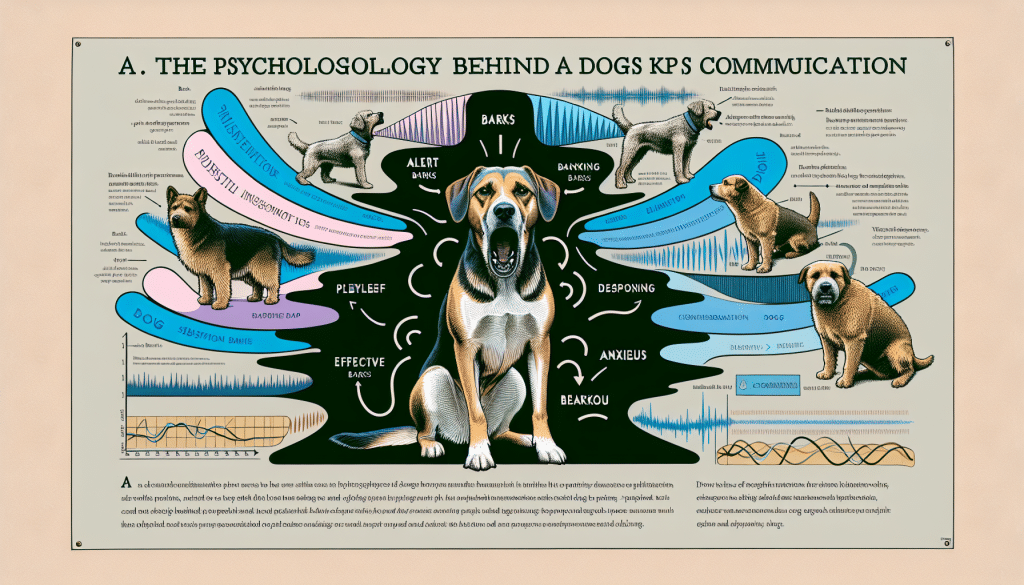Are you curious about why dogs bark and how to effectively respond to this behavior? In the article "Understanding the Psychology of Barking: Insights into Why Dogs Bark and Effective Response Strategies," we delve into the fascinating world of canine psychology to shed light on this common behavior. By gaining a deeper understanding of why dogs bark, you will be equipped with the knowledge to respond in a way that promotes their well-being and maintains a harmonious relationship between you and your furry friend. Get ready to explore the intricate world of dog barking and discover effective strategies to address this behavior.
Understanding the Psychology of Barking
Dogs communicate with us and their surroundings through barking, but excessive barking can become a problem for both the dog and the owner. To effectively address this behavior, it is crucial to understand the psychology of barking and the underlying causes. By gaining insight into why dogs bark, we can implement appropriate response strategies that promote a positive and enriched living environment for our furry friends.

This image is property of pixabay.com.
Causes of Excessive Barking
The first step in understanding barking behavior is recognizing the various causes behind excessive barking. Dogs may bark due to territorial instincts, fear, attention-seeking, or separation anxiety. Territorial barking is the dog's way of protecting its space, while fear barking occurs when a dog feels threatened or anxious. Attention-seeking barking is a way for dogs to gain the owner's attention, and separation anxiety barking arises from the distress of being left alone. Each cause requires a different approach in addressing the underlying issue.
Factors that Influence Barking Behavior
In addition to the specific causes, certain factors can influence barking behavior in dogs. One crucial factor is the breed and individual differences. Some breeds are naturally more vocal than others, while individual dogs within a breed may have varying barking tendencies. Understanding breed characteristics and considering individual traits is essential to tailor response strategies effectively.
The Importance of Identifying the Root Cause
To effectively address excessive barking, it is vital to identify the root cause behind the behavior. Differentiating between territorial, fear, attention, and separation anxiety barking is a crucial step in determining the appropriate response strategy. By understanding the specific triggers and emotional states that lead to barking, we can better communicate with our dogs and address their needs.
Differentiating between Territorial, Fear, Attention, and Separation Anxiety Barking
Territorial barking usually occurs when a dog feels the need to protect its home or property. It is often accompanied by a deep and persistent tone. Fear barking, on the other hand, arises from feelings of apprehension or discomfort, and the bark may be higher in pitch. Attention-seeking barking is characterized by a repetitive and insistent bark, as the dog is looking for interaction. Separation anxiety barking typically occurs when the dog is left alone and is characterized by continuous barking, often accompanied by destructive behavior.
Identifying Triggers and Emotional States
To effectively address barking, it is important to identify the triggers and emotional states that lead to the behavior. Dogs may bark in response to specific situations, such as the presence of strangers or loud noises, or they may exhibit signs of anxiety or agitation prior to barking. By observing their body language and vocalizations, we can better understand their communication and address their needs.
Using Body Language and Vocalizations to Understand Dogs' Communication
Dogs communicate not only through barking but also through their body language. Paying attention to their posture, facial expressions, and tail movements can provide valuable information about their emotional state. Additionally, the pitch, volume, and duration of barking can convey different messages. By interpreting their communication signals, we can respond appropriately and effectively address their barking behavior.
Environmental Factors and Barking
The environment plays a significant role in a dog's barking behavior. Noise pollution, lack of socialization, and instability can all contribute to excessive barking. Understanding these environmental factors can help us create a more suitable and calming environment for our dogs, ultimately reducing their excessive barking.
The Impact of Noise Pollution on Barking Behavior
Excessive noise can be a significant trigger for dogs' barking behavior. Loud noises such as construction sounds, fireworks, or traffic can cause dogs to feel stressed or threatened, leading to barking as a coping mechanism. Minimizing exposure to noise pollution and providing a safe and quiet space for our dogs can help alleviate excessive barking caused by environmental factors.
Socialization and its Effect on Barking
Proper socialization plays a crucial role in a dog's behavior, including their barking tendencies. Dogs that have been well-socialized from a young age are less likely to bark excessively when faced with new or unfamiliar situations. Introducing dogs to various people, animals, and environments can help them feel more comfortable and confident, ultimately reducing barking behavior.
The Influence of Routine and Stability
Routine and stability are essential for a dog's overall well-being and can also have an impact on their barking behavior. Dogs thrive in environments with consistent schedules, as it provides them with a sense of security and predictability. By maintaining a stable routine and creating a calm and structured living environment, we can promote a healthy and balanced lifestyle for our dogs, minimizing their tendency to bark excessively.

This image is property of pixabay.com.
Addressing Excessive Barking
Once we have identified the root cause of our dog's excessive barking, we can implement appropriate response strategies to address the behavior. Positive reinforcement training techniques, teaching the 'quiet' command, and utilizing distraction and redirection are all effective methods in curbing excessive barking and promoting desirable behavior.
Positive Reinforcement Training Techniques
Positive reinforcement training techniques involve rewarding desired behavior with treats, praise, or playtime. By reinforcing calm and quiet behavior, we can encourage our dogs to replace excessive barking with more desired behaviors. This approach focuses on rewarding good behavior rather than punishing unwanted behavior, creating a positive and trusting relationship between the dog and the owner.
Teaching the 'Quiet' Command
Teaching the 'quiet' command is another effective way to address excessive barking. By consistently using the command and rewarding the dog for quiet behavior, we can help them associate the command with stopping barking. Patience, consistency, and positive reinforcement are key in successfully teaching the 'quiet' command.
The Power of Distraction and Redirecting Attention
Distraction and redirecting attention are powerful techniques in addressing excessive barking. By redirecting the dog's focus to a different activity or providing an alternative outlet for their energy, we can prevent them from fixating on barking. Providing interactive toys, engaging in playtime, or incorporating mental stimulation exercises can help redirect their attention and reduce barking behavior.
Implementing Effective Response Strategies
Consistency and persistence are key when implementing response strategies to address excessive barking. It is essential to remain consistent in training efforts and response techniques to ensure long-term success. Additionally, providing physical and mental stimulation through regular exercise and interactive games can help release energy and reduce stress, promoting calmness in our dogs.

This image is property of pixabay.com.
Consistency and Persistence in Training
Training efforts must be consistent and persistent to address excessive barking effectively. Setting clear boundaries, adhering to a routine, and using consistent verbal cues can help our dogs understand what is expected of them. By remaining patient, positive, and persistent, we can establish new patterns of behavior and help our dogs overcome excessive barking tendencies.
Providing Physical and Mental Stimulation
Physical and mental stimulation are crucial for a dog's overall well-being and can contribute to reducing excessive barking. Regular exercise, such as walks, runs, or playtime, helps release pent-up energy and promotes relaxation. Additionally, incorporating mental stimulation through interactive toys, puzzle games, or training exercises can keep our dogs mentally engaged and content, reducing their likelihood of barking excessively.
Creating a Calm and Safe Environment
Creating a calm and safe environment is essential in addressing excessive barking. Providing a designated space for rest and relaxation, using comforting tools such as blankets or crates, and minimizing exposure to stress-inducing stimuli can all contribute to a peaceful living environment. By promoting a sense of security and predictability, we can help our dogs feel calm and reduce their need to bark excessively.
Using Desensitization and Counter Conditioning
Desensitization and counter conditioning are methods used to gradually expose dogs to triggering situations and reshape their emotional response. By gradually introducing the dog to the trigger that causes excessive barking and pairing it with positive experiences or rewards, we can help them associate the trigger with positive emotions rather than fear or anxiety. These techniques should be done under the guidance of professional trainers or behaviorists to ensure safety and effectiveness.
Gradually Exposing Dogs to Triggering Situations
Desensitization involves gradually exposing dogs to the situations or stimuli that trigger their excessive barking. This can be done by slowly increasing the proximity or intensity of the trigger while providing positive reinforcement and rewards for calm or quiet behavior. By incrementally exposing dogs to their triggers, we can help them develop a more relaxed and controlled response.

Rewiring the Emotional Response through Associative Learning
Counter conditioning aims to rewire the emotional response of dogs by associating the trigger with positive experiences. This can involve pairing the trigger with treats, playtime, or other enjoyable activities to help the dog develop a more positive association. Over time, dogs can learn to replace their excessive barking response with a more relaxed and positive emotional state.
Working with Professional Trainers
Desensitization and counter conditioning techniques can be complex and require professional guidance. Trained animal behaviorists or professional trainers can provide expertise and create customized plans to suit the specific needs of our dogs. Their knowledge and experience can help ensure that the methods used are safe and effective, resulting in successful behavior modification.
Utilizing Tools and Devices to Manage Barking
In some cases, tools and devices can be helpful in managing excessive barking. Bark collars, ultrasonic devices, and pheromone diffusers are among the options available. However, it is crucial to consider the benefits and limitations of these tools and use them responsibly and ethically, always prioritizing the well-being of our dogs.
The Benefits and Limitations of Bark Collars
Bark collars are devices that deliver a stimuli (such as a vibration or mild electric shock) when the dog barks excessively. While they can be effective in interrupting barking behavior, it is important to consider the potential impact on the dog's emotional well-being. Careful research, appropriate fit, and responsible use are necessary to ensure that bark collars are used safely and with consideration for the dog's comfort.
Considerations for Using Ultrasonic Devices
Ultrasonic devices emit a high-frequency sound that is inaudible to humans but can be heard by dogs. The sound is designed to interrupt barking behavior and redirect the dog's attention. It is essential to use these devices judiciously, considerate of the dog's well-being and avoid causing any distress or fear. Ultrasonic devices should always be used as part of a comprehensive training plan and under the guidance of a professional.

Exploring Pheromone Diffusers and Calming Supplements
Pheromone diffusers, such as Adaptil, release synthetic pheromones that mimic the hormones produced by nursing mother dogs. These pheromones can create a calming effect and help reduce stress and anxiety in dogs, potentially leading to a decrease in barking behavior. Similarly, calming supplements or natural remedies, when used in consultation with a veterinarian, can help promote relaxation and reduce excessive barking behavior in certain situations.
Understanding the Role of Human Behavior
Human behavior and interactions can significantly influence a dog's barking tendencies. It is important to be mindful of inadvertent reinforcement of barking, emotional contagion, and the establishment of clear communication and trust with our dogs.
Avoiding Inadvertent Reinforcement of Barking
Inadvertent reinforcement of barking occurs when owners unknowingly reward their dog's barking behavior. This can happen when the dog barks for attention or when the owner reacts to the barking with unintentional reinforcement, such as yelling or giving treats. To avoid inadvertently reinforcing barking, it is essential to withhold attention and rewards until the dog is calm and quiet, redirecting their behavior to more desirable alternatives.
Emotional Contagion and Its Influence on Dogs' Behavior
Dogs are highly attuned to human emotions and can be influenced by our own stress or anxiety. Emotional contagion occurs when dogs pick up on our emotions and mirror them in their own behavior, leading to an increase in barking. By practicing calmness and providing a positive and reassuring demeanor, we can help our dogs feel more secure and reduce their tendency to bark excessively.
Promoting Trust and Establishing Clear Communication
Building trust and establishing clear communication are essential for effective barking behavior management. Dogs rely on their owners for guidance and reassurance. By using consistent verbal cues, maintaining a calm and patient approach, and providing positive reinforcement, we can foster a strong bond with our dogs and effectively communicate our expectations. Clear communication and trust create a harmonious relationship and promote desirable behavior.
Seeking Professional Help for Persistent Barking
If excessive barking persists despite efforts to address the behavior, it may be necessary to seek professional help. Veterinarians and animal behaviorists can provide expert guidance, evaluate the underlying causes of the barking, and develop customized plans tailored to the specific needs of the dog. Professional evaluation and intervention can offer valuable insights and solutions for effectively managing persistent barking.
When to Consult with a Veterinarian or Animal Behaviorist
Consulting with a veterinarian or animal behaviorist is recommended when excessive barking becomes a persistent issue or when the underlying cause is unclear. These professionals can conduct a thorough evaluation, rule out any underlying medical conditions, and provide expert advice on behavior modification techniques. They can offer comprehensive support to ensure the well-being of the dog and help owners effectively manage barking behavior.
Understanding the Use of Medication as a Last Resort
In some cases, medication may be recommended as a last resort to manage excessive barking. Medication should always be prescribed and supervised by a veterinarian and used as part of a comprehensive behavior modification plan. It is important to prioritize the well-being of the dog and carefully consider the benefits and potential side effects of any medication.
The Benefits of Professional Evaluation and Customized Plans
Professional evaluation and customized behavior modification plans offer the advantage of expert guidance and tailored strategies. These customized plans take into account the specific needs and individual differences of each dog. By working with professionals, owners can gain a deeper understanding of their dog's behavior and access the support needed to effectively manage excessive barking.
Promoting Well-being through Exercise and Enrichment
Physical exercise and mental stimulation play a vital role in a dog's overall well-being and can contribute to reducing excessive barking. By providing opportunities for physical activities and mental enrichment, we can help our dogs release energy, reduce stress, and maintain a balanced lifestyle.
Physical Activities to Release Energy and Reduce Stress
Regular physical exercise is essential for dogs to release pent-up energy and reduce stress levels. Engaging in activities such as daily walks, runs, or interactive play sessions can provide an outlet for excess energy and help prevent barking behavior caused by restlessness or frustration. By ensuring our dogs receive appropriate exercise, we can contribute to their well-being and promote a calm and contented state of mind.
Mental Stimulation and Interactive Toys
Mental stimulation is equally important in promoting a healthy and balanced lifestyle for our dogs. Engaging their minds through puzzle toys, interactive games, and training exercises can help them stay mentally sharp and reduce boredom-related barking. Providing a variety of toys and activities that challenge their problem-solving abilities and reward their efforts can keep their minds engaged and satisfied.
Creating a Positive and Enriched Living Environment
In addition to exercise and mental stimulation, creating a positive and enriched living environment is crucial in reducing excessive barking. This includes providing comfortable resting areas, offering a variety of toys and chew items, and incorporating positive experiences, such as regular outings or playdates. By enriching their living environment, we can help our dogs feel content and fulfilled, minimizing the likelihood of excessive barking.
By understanding the psychology of barking and implementing appropriate response strategies, we can address excessive barking in our dogs and create a harmonious living environment. Remember to approach barking behavior with patience, kindness, and consistency, and always prioritize the well-being of your furry companion. With proper understanding and effective management techniques, we can promote a peaceful and fulfilling life for both dogs and their owners.


